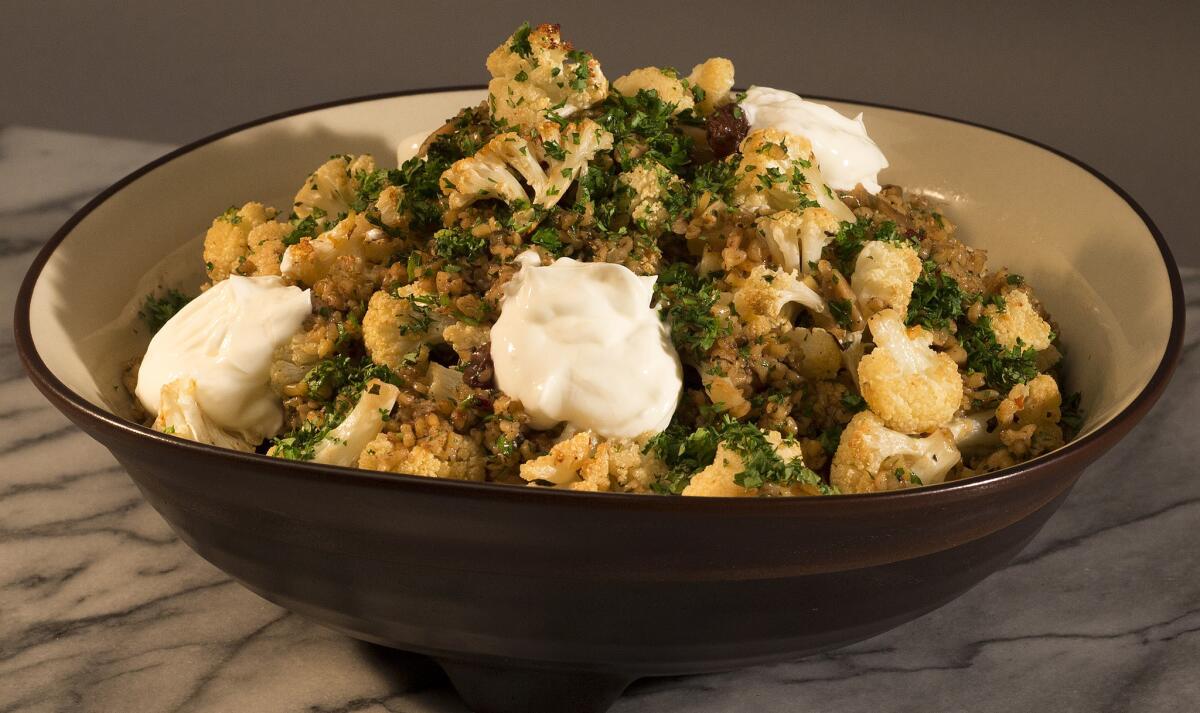Embracing a grain called freekeh, with help from the experts

- Share via
The great grain parade keeps on growing. You’ve mastered barley, farro and even quinoa, are you ready to get freekeh?
The latest entry in the seemingly ever-expanding universe of whole grains, freekeh is a Middle Eastern grain made from green wheat that’s been harvested before it’s mature and then roasted. And it’s delicious. Think of an earthier farro or a chewier barley.
Traditionally, freekeh was prepared by sun-drying the grain and then burning it to remove the chaff and straw. This gave a smoky flavor that you still find referred to in some descriptions. Whatever smoke there might be today is not very noticeable — probably these days it’s simply roasted to dry — but it’s terrific anyway.
You prepare it much as you would other grains: a brief toast to deepen the flavor, then add water and simmer as you would rice, until the liquid is completely absorbed. You will find widely varying advice on the ratio of water to grain, ranging from 5 cups of water for every cup of grain to 1¼ cups.
That last ratio comes from Israeli-born chef and cookbook writer Yotam Ottolenghi, and cooked this way (there’s a brief soak involved first), the grain is tender but still resilient. You can serve it warm for a pilaf or cool it completely and use it as the base for a whole-grain salad.
In his cookbook “Jerusalem,” Ottolenghi makes a kind of mujadara with caramelized onions and warm spices, substituting freekeh for the more usual lentils and rice. Served just with garlic-scented yogurt, this is a very nice dish.
To make it more of a main course, I added raisins and toasted almonds to the base and finished it with cauliflower roasted with cumin and fruity Marash pepper (you can substitute any cracked red pepper for much the same effect).
This gives what was a simple, satisfying combination a much wider range of flavors and textures: soft, sweet raisins; the slightly bitter browned onions; chewy, nutty grain; crunchy almonds; and the bright flavors of fresh parsley and mint.
Because of its rich, nutty flavor and chewy texture, freekeh adapts to all kinds of salads with fresh herbs, assertive greens and cold cooked vegetables. The first time I tried it was several years ago at a small Syrian restaurant outside of Portland, Ore., served in a salad with shredded rotisserie chicken.
I also like a recipe I found in Lebanese food blogger Maureen Abood’s upcoming cookbook, “Rose Water and Orange Blossoms.” She prepares a freekeh pilaf with chickpeas and cooks it in a tomato paste-spiked broth.
Freekeh can still be something of a challenge to find, but that won’t last. Look how quickly quinoa become ubiquitous. For now, you can find it at Middle Eastern groceries, in the grain section of natural foods supermarkets or order it online (Amazon has a variety of brands available).
I get mine at the bustling, friendly Altayabet Market on Brookhurst Street in Anaheim’s Little Arabia. The first time I just waited to spot a shopper who seemed to be particularly knowledgeable, and when I asked her, she pointed me to the Ziyad brand as being particularly good. She also turned me on to her favorite brand of tahini and told me which feta she thought was creamiest.
That never happened when I was shopping for quinoa.
More to Read
Eat your way across L.A.
Get our weekly Tasting Notes newsletter for reviews, news and more.
You may occasionally receive promotional content from the Los Angeles Times.











